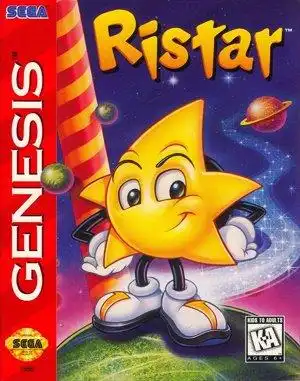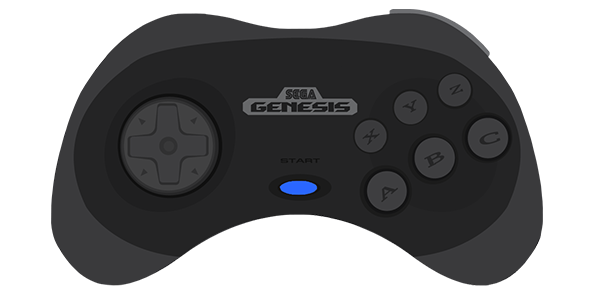Finding a true hidden gem in the vast library of the Sega Genesis is a special kind of thrill for any retro gamer. While Sonic hogged the spotlight, other fantastic titles quietly graced the 16-bit console, often arriving late in its lifecycle. One such game, a quirky platformer featuring a stretchy-armed protagonist, stands out: Ristar Sega Genesis.
Released in 1995, Ristar arrived just as the industry's focus shifted to the next generation. This timing meant it didn't get the massive push it deserved, but those who found it discovered a game brimming with creativity and charm. Forget blistering speed; Ristar is about precision, puzzle-solving, and leveraging a truly unique mechanic.
What Exactly is Ristar?
At its core, Ristar is a 2D side-scrolling platformer, but it immediately distinguishes itself from its peers. You play as Ristar, a star-shaped hero tasked with saving the Valdi star system from the tyrannical Kaiser Greedy. The story, which had slightly different versions between Japan and the West (one involving a star mother, the other a kidnapped hero father), sets the stage for a vibrant journey across seven distinct planets.
Unlike the typical jump-and-run hero, Ristar's primary ability isn't speed or a spin dash. It's his incredibly elastic arms, which can stretch in eight directions. This isn't just for show; it's the foundation of almost everything you do in the game.
The Stretchy Star: Gameplay Mechanics Unpacked
This is where Ristar truly shines. The stretchy arms are used for:
- Combat: Grab enemies from a distance and deliver a headbutt. It feels surprisingly tactile and satisfying.
- Movement: Swing from poles, grab onto walls or ceilings, and latch onto special "Star Handles" to build momentum and launch yourself across gaps or through barriers. This mechanic is central to navigation and puzzle-solving.
- Interaction: Open treasure chests, pull levers, grab objects, and interact with unique environmental elements on each planet.
The level design masterfully incorporates this mechanic. You'll swing through jungles, pull yourself through icy caverns, navigate underwater currents by grabbing specific points, and even carry items through fiery landscapes. Each planet introduces new gimmicks that keep the gameplay fresh and constantly challenge you to think about how to use Ristar's grab in new ways.
While the game isn't built around speed like Sonic, mastering the Star Handles allows for some incredibly fast traversal and opens up hidden paths. Achieving enough speed with a handle even lets Ristar perform a powerful "Meteor Strike."
A Feast for the Eyes (and Ears?)
Visually, Ristar is a standout on the Genesis. The developers pushed the hardware, creating incredibly colorful and vibrant levels with large, expressive sprites and impressive parallax scrolling. Each planet has a distinct and memorable theme, brought to life with a rich palette that makes the game pop. While some moments with lots of action might cause a little slowdown, the overall presentation is top-notch for the era.
The music and sound effects are decent, fitting the cheerful and sometimes quirky atmosphere. While not as iconic as Sonic's soundtrack, the tunes are pleasant and contribute positively to the experience.
Why Was It Overlooked?
Ristar's fate was largely sealed by its release timing. Arriving in 1995, the Sega Saturn was already on the horizon, and the Genesis was winding down. Most gamers and the press were looking ahead, meaning Ristar didn't get the marketing push or attention it deserved. Despite generally positive reviews at the time, it never achieved the commercial success or cultural impact of its blue hedgehog predecessor.
Interestingly, Ristar has often been retroactively associated with Sonic Team, and while some key staff members did work on both, its development origins are a bit debated. Regardless of the exact team, the quality and polish are undeniable.
Where Can You Play Ristar Today?
Thankfully, Ristar's status as an overlooked gem has led to numerous re-releases over the years. You can find this fantastic platformer on:
- Various Sega Genesis/Mega Drive compilations (like the Sega Genesis Collection).
- Digital storefronts (often available on platforms like Steam).
- Included with services like Nintendo Switch Online + Expansion Pack.
- Featured on the Sega Genesis Mini console.
This means experiencing Ristar's unique adventure is easier than ever, whether you have original hardware or prefer modern emulation.
Conclusion
Ristar on the Sega Genesis is more than just a historical footnote; it's a genuinely excellent platformer that offers a refreshing change of pace. Its unique stretchy arm mechanic is intuitive and deeply explored through creative level design. The vibrant graphics still hold up, making it a joy to play.
If you're a fan of 16-bit platformers or just curious about the games that didn't get the superstar treatment, give Ristar a try. It's a brilliant, charming, and often challenging adventure that absolutely deserves its reputation as one of the Genesis's finest hidden gems.
FAQ
Q: Is Ristar a Sonic Team game? A: While some key developers who worked on Sonic were involved with Ristar, and it's often included in Sonic compilations, the official development team origin is sometimes debated. It's safe to say there's a strong connection in terms of talent and Sega's internal studios.
Q: Is Ristar a difficult game? A: Ristar offers a good challenge. While some might find the bosses relatively easy, the platforming and environmental puzzles can be tricky, especially mastering the momentum-based swinging. Some players note an uneven difficulty curve, but overall, it provides a satisfying challenge without being overly punishing.
Q: How long is Ristar? A: A typical playthrough of Ristar might take a few hours, depending on your skill level and how much you explore for hidden items and bonus stages. It's a concise, well-paced experience.


